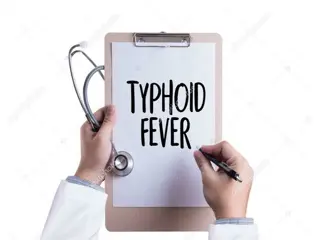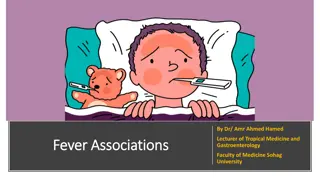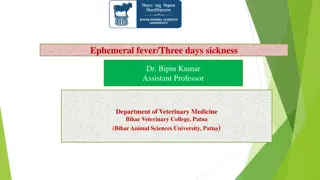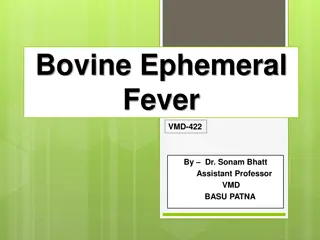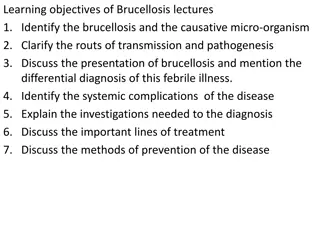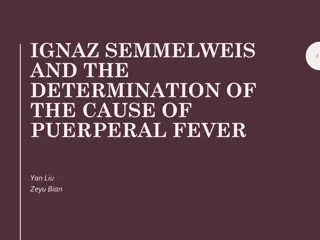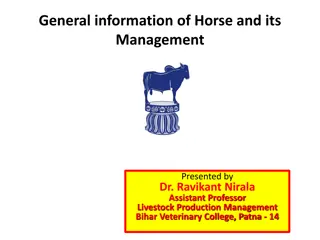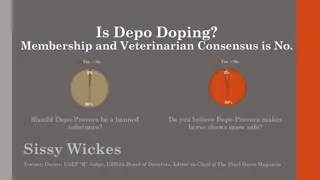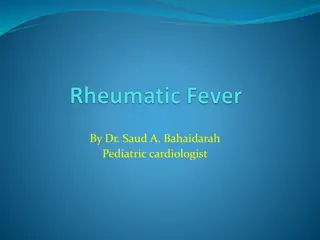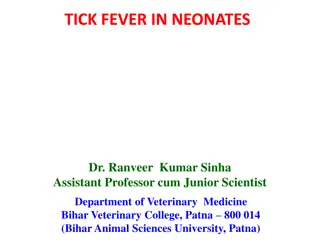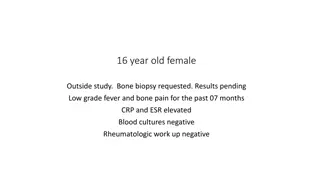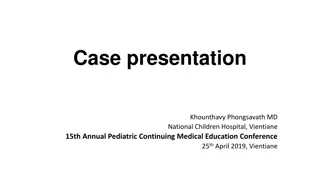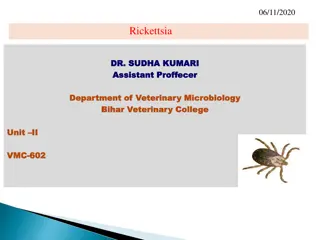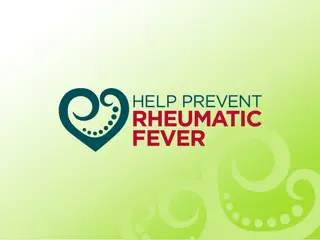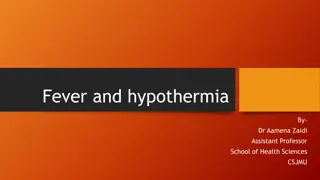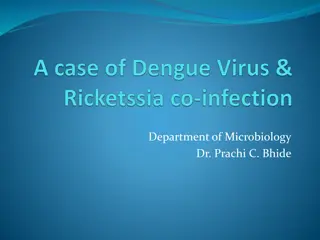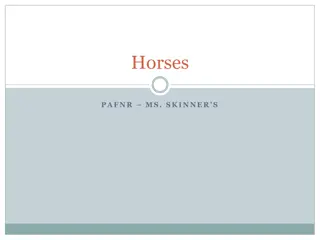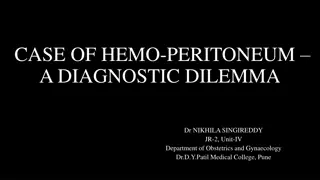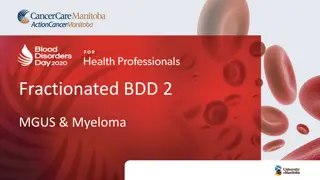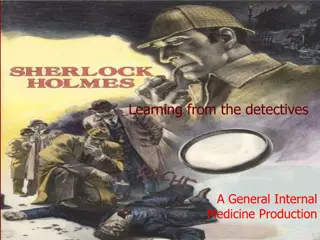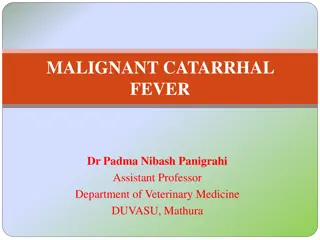Potomac Horse Fever: Clinical Presentation and Diagnostic Plan
A 5-year-old Quarter Horse gelding presents with symptoms of colic and possible Potomac Horse Fever. Initial physical examination reveals sweating, tachycardia, and abnormal bowel sounds. The differential diagnoses include gastrointestinal infections, viral and bacterial causes. The diagnostic plan includes colic work-up, blood tests, abdominal ultrasound, and a PCR panel for infectious gastroenteritis.
Download Presentation

Please find below an Image/Link to download the presentation.
The content on the website is provided AS IS for your information and personal use only. It may not be sold, licensed, or shared on other websites without obtaining consent from the author. Download presentation by click this link. If you encounter any issues during the download, it is possible that the publisher has removed the file from their server.
E N D
Presentation Transcript
Potomac Horse Fever: Potomac Horse Fever: Neorickettsia risticii risticii Enterocolitis in the Horse Enterocolitis in the Horse Abigail Spike Neorickettsia University of Illinois, 2024 Mentor: Dr. John Vacek, DVM
Signalment & History 5-year-old Quarter Horse Gelding Presenting Complaint: stretching out to urinate, possible colic Owner gave oral flunixin meglumine 2 hours prior to arrival Passed manure during trailer ride No change in feed or exercise No prior history of colic Up to date on vaccines according to owner Out in pasture during the day, in a stall at night. Fed senior feed and hay
Clinical Findings Initial Physical Examination Sweating Temperature: 101.0 F Heart Rate: 52 beats per minute Respiratory Rate: 44 breaths per minute Mucous Membranes: bright pink Capillary Refill Time: 2 sec Digital Pulses: unremarkable Borborygmi: decreased in upper quadrants, within normal limits in lower right quadrant, increased in lower left quadrant
Problem List Stretching out Sweating Tachycardia Tachypnea Abnormal Borborygmi Bright pink mucous membranes Prolonged capillary refill time Colic Signs
Differential Diagnoses Colic o Bright pink mucous membranes o Endotoxemia o Septic Shock Prolonged Capillary Refill Time o Dehydration o Decreased Perfusion (shock) Gastrointestinal Infection Bacterial: Neorickettsia risticii, Salmonella spp., Clostridium spp., Rhodococcus equi, Lawsonia intracellularis Viral: Equine Coronavirus, Equine Rotavirus Parasitic: Strongyles, Cryptosporidium spp. Gastrointestinal ulceration Non-Steroidal anti-inflammatory drug intoxication Toxins: cantharidin, Nerium oleander Displacement Gas Colic Spasmodic Colic Entrapment Strangulation Torsion Ileus Impaction o o o o o o o o o o o Infectious inflammatory disease is the top differential and can explain all the problems that are present. Given the patient s signalment and presentation, most probable etiologic agents include Neorickettsia risticii, Salmonella spp., Clostridium spp., and Equine Coronavirus Differentials are listed from higher to lower likelihood for this patient.
Diagnostic Plan Colic Work Up - based on physical examination findings and presentation Pack Cell Volume, Total Protein, and Serum Amyloid A Rectal Palpation Nasogastric Tube Abdominal Ultrasound Complete Blood Count and Serum Chemistry - based on physical exam and colic workup findings Adult GI PCR Panel - based on bloodwork and clinical signs, suspicious for Potomac Horse Fever or other infectious gastroenteritis
Diagnostic Plan Colic Workup Sedated with 200 mg Xylazine IV Initial Bloodwork: PCV: 46, TP: 5.8, SAA: 0 Rectal examination: cowpie feces in rectum, no other abnormalities noted Nasogastric tube: no reflux. Administered gallon mineral oil, gallon water, and electrolytes. Abdominal Ultrasound: small intestine slightly enlarged but motile at left lower flank, gas in colon at ventral midline, all other findings unremarkable
Diagnostic Plan Bloodwork Complete Blood Count and Serum Chemistry Leukopenia Neutropenia o Inflammation Lymphopenia o Stress vs protein losing enteropathy Hyperglycemia o Fear vs stress Hypomagnesemia o Enterocolitis (endotoxemia) Hypoproteinemia o Protein losing enteropathy Hypoglobulinemia Low AST Hyperbilirubinemia o Anorexia/fasting Kendall Road Equine Hospital
Diagnostic Plan Adult GI PCR Panel Fecal sample collected and sent out on Day 2 Neorickettsia risticii detected Kendall Road Equine Hospital
Diagnosis Neorickettsia risticii infection Previous name: Ehrlichia risticii Common name: Potomac Horse Fever May also be termed Equine Ehrlichial Colitis Consistent Clinical Pathology Leukopenia Neutropenia Lymphopenia Protein losing enteropathy Consistent Clinical Signs Fever Anorexia Mild colic Bright pink mucous membranes Prolonged capillary refill time Dehydration Shock Endotoxemia Decreased borborygmi Cowpie feces
Progression The patient was hospitalized for 8 days Day 2: became pyretic with a temperature of 103 F Day 3: dark pink mucous membranes, SAA of 553, and was displaying more signs of colic, including pawing, stretching out, lateral recumbency, side watching The patient continued to intermittently display signs of colic for several days following presentation. He also had several inconsistent occasions of anorexia. Day 4: Repeated Complete Blood Count and Serum Chemistry o Monocytosis - inflammation o Hyponatremia - hypotonic fluid administration o Panhypoproteinemia - protein losing enteropathy o Low AST Kendall Road Equine Hospital
Therapeutic Plan Hospitalization o Intravenous Fluid Therapy: Lactated Ringer s Solution + Calcium + Dextrose o Antibiotics: Oxytetracycline: 25 mL (6 mg/kg) IV q24h for 5 days Doxycycline: 1 scoop (10 mg/kg) PO q12h. Starting after 5-day course of oxytetracycline. Some cases relapse after discontinuation of antibiotic treatment, which may be mitigated by prolonging treatment. Doxycycline has similar efficacy against N. risticii as oxytetracycline and can be given orally which facilitates continued administration after removal of an intravenous catheter and after the horse returns home. o Flunixin Meglumine: 10 mL (0.5 mg/lb) IV PRN for visceral pain or pyrexia (was not needed beyond the day 3) o Misoprostol: 1 scoop (2.4 mg) PO q12h. Intermittent signs of colic raised concern for gastric or colonic ulceration, which warranted the addition of Misoprostol beginning on day 4 of treatment. Assess vaccination protocol for this horse and other horses at the barn based on individual circumstances (infection history, vaccination history, location, prevalence). Vaccination efficacy is variable and may or may not reduce clinical severity of disease. Assess environmental management: consider proximity of barn/pastures to bodies of water and snail/insect deterrent during warm months and in areas with increasing prevalence of cases. Neorickettsia risticii is not contagious, but other horses residing at the same barn may also be exposed to the source of infection.
Outcome Medical management improved clinical signs and bloodwork Patient was hospitalized for 8 days and then discharged. On day 8, patient was bright, physical examination was unremarkable, had no signs of colic, and SAA was down to 112. Discharge Instructions: Medication: 1 scoop doxycycline PO q12h until tub is gone, 1 scoop misoprostol q12h until tub is gone (3 days) and then reassess if more misoprostol is needed. Exercise: hand walk or small solitary turnout for 1 week and then slow return to exercise. Gradual return to grass pasture turnout. Feeding: feed multiple small meals if possible, slowly increase feedings to normal amount, monitor water intake, offer oral electrolytes Monitor manure and temperature Vaccination: follow up with primary veterinarian to assess vaccination protocol for Potomac Horse Fever
References & Permissions References & Further Reading Baird JD, Arroyo LG. Historical aspects of Potomac horse fever in Ontario (1924-2010). Can Vet J. 2013 Jun;54(6):565-72. Bertin FR, Reising A, Slovis NM, Constable PD, Taylor SD. Clinical and Clinicopathological Factors Associated with Survival in 44 Horses with Equine Neorickettsiosis (Potomac Horse Fever). J Vet Int Med, 2013 Oct;27(6):1528-1534 Mulville P. Equine monocytic ehrlichiosis (Potomac horse fever): a review. Equine Vet J. 1991;23: 400-404. Palmer J. Potomac Horse Fever. Vet Clin North Am Equine Pract. 1993;9(2):399-410. Uzal FA, Diab SS. Gastritis, Enteritis, and Colitis in Horses. Vet Clin North Am Equine Pract. 2015 Aug;31(2):337-58. Permissions Thank you to Dr. John Vacek and Kendall Road Equine Hospital for permission to present this case and for the resources pertaining to it, including images of laboratory results included in this presentation.
Potomac Horse Fever: Potomac Horse Fever: Neorickettsia risticii Neorickettsia risticii Enterocolitis in the Horse Enterocolitis in the Horse Abigail Spike, 2024 University of Illinois Outcome Medical management improved clinical signs and bloodwork On day 8, patient was BAR, physical examination was unremarkable, no signs of colic, and SAA was down to 112. Discharge Instructions: Medication: 1 scoop doxycycline PO q12h until tub is gone, 1 scoop misoprostol q12h until tub is gone (3 days) and then reassess if more misoprostol is needed. Exercise: hand walk or small solitary turnout for 1 week and then slow return to exercise. Gradual return to grass pasture turnout. Feeding: feed multiple small meals if possible, slowly increase feedings to normal amount, monitor water intake, offer oral electrolytes Monitor manure and temperature Vaccination: follow up with primary veterinarian to assess vaccination protocol for Potomac Horse Fever Treatment Plan IV Fluids: LRS + Calcium + Dextrose Oxytetracycline: 25 mL (6 mg/kg) IV q24h for 5 days Doxycycline: 1 scoop (10 mg/kg) PO q12h. Starting after 5-day course of oxytetracycline. Flunixin Meglumine: 10 mL (0.5 mg/lb) IV PRN Misoprostol: 1 scoop (2.4 mg) PO q12h. Started on day 4; intermittent signs of colic raised concern for gastric or colonic ulceration. Assess vaccination protocol for this horse and other horses at the barn based on individual circumstances (infection history, vaccination history, location, prevalence). Vaccination efficacy is variable and may or may not reduce clinical severity of disease. Assess environmental management: consider proximity of barn/pastures to bodies of water and snail/insect deterrent during summer/fall and in areas with increasing prevalence of cases. Presenting Complaint Stretching out to urinate, possible colic Diagnostic Testing Colic Work Up PCV: 46, TP: 5.8, SAA: 0 Rectal examination: cowpie feces in rectum, no other abnormalities noted Nasogastric tube: no reflux. Administered gallon mineral oil, gallon water, and electrolytes. Abdominal Ultrasound: small intestine slightly enlarged but motile at left lower flank, gas in colon at ventral midline, all other findings unremarkable CBC/Chemistry Leukopenia, Neutropenia, Lymphopenia, Hyperglycemia, Hypomagnesemia, Hypoproteinemia, Hypoglobulinemia, Low AST, Hyperbilirubinemia Adult GI PCR Panel Neorickettsia risticii detected Signalment 5-year-old Quarter Horse Gelding History Owner gave oral flunixin meglumine 2 hours prior to arrival Passed manure during trailer ride No change in feed or exercise No prior history of colic Up to date on vaccines according to owner Out in pasture during the day, in a stall at night. Fed senior feed and hay Clinical Findings Sweating Temperature: 101.0 F Heart Rate: 52 beats per minute Respiratory Rate: 44 breaths per minute Mucous Membranes: bright pink Capillary Refill Time: 2 sec Digital Pulses: unremarkable Borborygmi: decreased in upper quadrants, within normal limits in lower right quadrant, increased in lower left quadrant Diagnosis Neorickettsia risticii (Potomac Horse Fever) Progression Hospitalization for 8 days Day 2: Pyrexia (103 F) Day 3: Dark pink mucous membranes, SAA of 553, pawing, lateral recumbency, side watching Intermittent, mild colic and anorexia Day 4: Repeated Bloodwork: monocytosis, hyponatremia, panhypoproteinemia, low AST 2022 Student and New Graduate Case Study Competition


